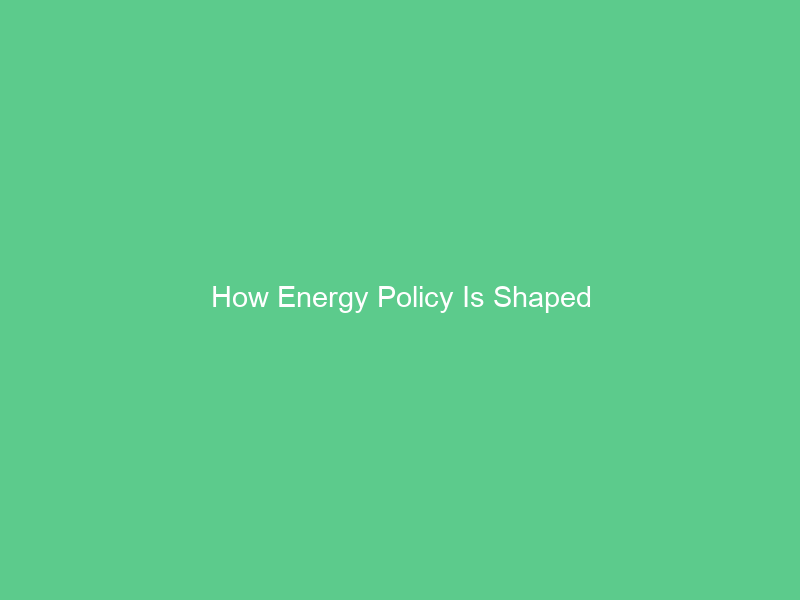Energy policy defines our collective behavior when it comes to producing, consuming and disseminating energy. Institutions from local governments to international trade organizations enact various policies designed to influence energy-related behaviors.
On balance, most Americans support prioritizing alternative energy sources over expanding the production of oil, coal and natural gas – however young Republicans are less likely than their elder counterparts to support such proposals.
Investing in Cleaner Energy
Providing energy that is affordable, clean and secure for all is a crucial challenge for all nations. Energy policies determine how countries produce, consume, transport and manage their energy systems – and consequently their greenhouse gas emissions levels.
Policies that shape energy production and consumption span an array of regulations. They range from building energy codes, air pollution standards, tax credits and wildlife protection requirements, all the way to regulations related to waste management.
These policies offer investors opportunities to benefit from the energy transition. Companies that can take advantage of it can be found everywhere: solar and wind power investments lead the clean investment pack in California, Texas, Florida, Georgia and North Carolina; heat pumps take the cake for investments across much of the United States; while zero-emission vehicles receive particular attention due to transportation being responsible for much of their state’s emissions.
Investing in Innovation
Governments employ various policy instruments to influence energy-related behaviors, such as building codes, tax credits and energy efficiency standards. Such policies have an effect on energy consumption but some policies can be more successful at shifting our nation’s energy balance than others. Governments may fund research or encourage development to catalyze technologies not yet on the market.
Federal energy technology programs must alter their focus to emphasize conceptual and technical work instead of loan guarantees, production tax credits or renewable portfolio standards that attempt to force premature commercialization.
An integrated internal energy market provides price signals to promote green investments, increase consumer incentives and secure supply. It is the least costly path towards climate neutrality; yet to achieve it requires determination, cooperation and solidarity among EU Member States – goals which may prove challenging when fossil fuel interests spend 10 times more trying to influence policymakers than necessary.
Investing in American Workers
Energy policies of any country represent the interests of various stakeholders, including economic development, geopolitical security, climate action and rapid deployment of new technology. Each group’s ability to exert pressure on decisionmakers and hold them accountable determines how their policies are shaped.
Supporting workforce strategies that equip local communities and workers with the skills, credentials, and opportunities they need for economic advancement is critical to local communities and workers. These include supporting partnerships between unions and community organizations in building talent pipelines for high-quality jobs; investing in pre-apprenticeship programs which lead to registered apprenticeships; expanding public workforce system initiatives & career and technical education initiatives; assuring construction workers on federally assisted projects are paid prevailing wages while provided supportive services such as childcare or transportation assistance;
Ensuring all Americans have access to reliable and affordable clean energy is our top priority, including expanding energy efficiency investments to low-income households and expanding renewable electricity access. Furthermore, supporting innovative domestic manufacturing capabilities as well as upholding US leadership in key clean energy technologies is vitally important.
Investing in a Cleaner Economy
Clean energy transition has tremendous economic advantages for society as a whole. Up-front investments in renewables and grids pay dividends over time through reduced fuel costs, improved efficiency standards and decreased consumption requirements for homes, office buildings, automobiles and industrial processes.
Dollar for dollar, these investments will yield significant economic returns and enable the US to meet global climate goals – goals which in turn boost economic growth, create jobs, and expand new industries.
Lower pollution levels and improve health outcomes for vulnerable communities by lowering pollution levels and improving air quality, especially among those who bear a disproportionate burden of asthma, heart disease and other respiratory ailments caused by air pollution. Many of these communities already bear the burden of racial and economic inequality; thus prompting the Biden-Harris Administration to undertake one of the largest investments ever in clean energy and climate protections ever seen in America – including incentives for clean tech manufacturing/production as well as extended tax credits.

